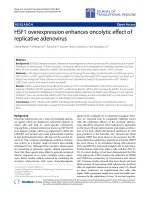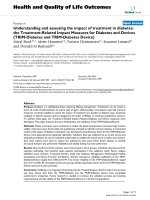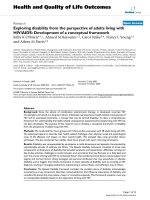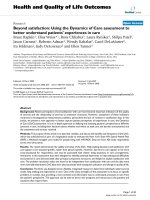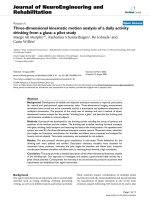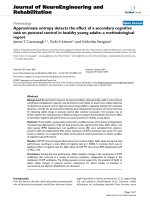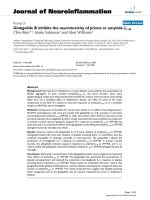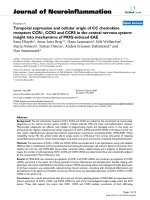báo cáo hóa học: " Approximate entropy detects the effect of a secondary cognitive task on postural control in healthy young adults: a methodological report" docx
Bạn đang xem bản rút gọn của tài liệu. Xem và tải ngay bản đầy đủ của tài liệu tại đây (475.5 KB, 7 trang )
BioMed Central
Page 1 of 7
(page number not for citation purposes)
Journal of NeuroEngineering and
Rehabilitation
Open Access
Methodology
Approximate entropy detects the effect of a secondary cognitive
task on postural control in healthy young adults: a methodological
report
James T Cavanaugh*
1
, Vicki S Mercer
2
and Nicholas Stergiou
3
Address:
1
Department of Physical Therapy, University of New England, Portland, ME, USA,
2
Department of Allied Health Sciences, The University
of North Carolina at Chapel Hill, Chapel Hill, NC, USA and
3
HPER Biomechanics Laboratory, University of Nebraska at Omaha, Omaha, NE, USA
Email: James T Cavanaugh* - ; Vicki S Mercer - ; Nicholas Stergiou -
* Corresponding author
Abstract
Background: Biomechanical measures of postural stability, while generally useful in neuroscience
and physical rehabilitation research, may be limited in their ability to detect more subtle influences
of attention on postural control. Approximate entropy (ApEn), a regularity statistic from nonlinear
dynamics, recently has demonstrated relatively good measurement precision and shown promise
for detecting subtle change in postural control after cerebral concussion. Our purpose was to
further explore the responsiveness of ApEn by using it to evaluate the immediate, short-term effect
of secondary cognitive task performance on postural control in healthy, young adults.
Methods: Thirty healthy, young adults performed a modified version of the Sensory Organization
Test featuring single (posture only) and dual (posture plus cognitive) task trials. ApEn values, root
mean square (RMS) displacement, and equilibrium scores (ES) were calculated from anterior-
posterior (AP) and medial-lateral (ML) center of pressure (COP) component time series. For each
sensory condition, we compared the ability of the postural control parameters to detect an effect
of cognitive task performance.
Results: COP AP time series generally became more random (higher ApEn value) during dual task
performance, resulting in a main effect of cognitive task (p = 0.004). In contrast, there was no
significant effect of cognitive task for ApEn values of COP ML time series, RMS displacement (AP
or ML) or ES.
Conclusion: During dual task performance, ApEn revealed a change in the randomness of COP
oscillations that occurred in a variety of sensory conditions, independent of changes in the
amplitude of COP oscillations. The finding expands current support for the potential of ApEn to
detect subtle changes in postural control. Implications for future studies of attention in
neuroscience and physical rehabilitation are discussed.
Introduction
Over the last two decades, dual task studies examining the
role of attention in postural control have become increas-
ingly important in clinical neuroscience [1,2], engineering
[3], and physical rehabilitation [4,5]. However, while
techniques for evaluating attention have become more
Published: 30 October 2007
Journal of NeuroEngineering and Rehabilitation 2007, 4:42 doi:10.1186/1743-0003-4-42
Received: 3 January 2007
Accepted: 30 October 2007
This article is available from: />© 2007 Cavanaugh et al; licensee BioMed Central Ltd.
This is an Open Access article distributed under the terms of the Creative Commons Attribution License ( />),
which permits unrestricted use, distribution, and reproduction in any medium, provided the original work is properly cited.
Journal of NeuroEngineering and Rehabilitation 2007, 4:42 />Page 2 of 7
(page number not for citation purposes)
sophisticated [6], dual task methods for evaluating pos-
tural control have progressed little. Specifically, research-
ers generally have relied upon degraded postural stability,
operationally defined as an increase in the amplitude of
center of pressure (COP) variability, to indicate interfer-
ence from a secondary cognitive task [7-15]. Postural sta-
bility measures, perhaps because of their relatively limited
precision [16], have not consistently revealed changes in
postural control during cognitive perturbations
[7,10,12,15,17]. Thus, the automaticity of postural con-
trol remains the subject of ongoing debate [18].
As an alternative measure of postural control, approxi-
mate entropy (ApEn) has been used to quantify COP var-
iability during quiet standing [19]. ApEn quantifies the
amount of irregularity, or randomness, in a time series
[20]. A small but growing body of evidence supports the
use of ApEn for detecting subtle changes in COP variabil-
ity that are not necessarily apparent using biomechanical
measures of postural stability [21,22]. Moreover, ApEn
has demonstrated relatively high response stability and
precision for repeated trials of quiet standing within a sin-
gle session [16]. This particular quality suggests that ApEn
might be useful in dual task studies of attention, in which
changes in postural control typically are evaluated over
very short time intervals.
Our purpose in the present study was to use a dual task
paradigm to conduct a preliminary evaluation of whether
ApEn could detect a short-term change in postural control
in response to the addition of a secondary cognitive task.
To minimize the influence of age and pathology, we
selected healthy, young adults as participants. We used a
modified version of a common clinical test battery, the
Sensory Organization Test (SOT; NeuroCom, Inc., Clack-
amas, OR), to test dual task performance under various
sensory conditions. In contrast to a motoric challenge, the
SOT provided an opportunity to collect steady-state (i.e.,
quiet standing) postural control data suitable for the
application of ApEn. To further understand the potential
utility of ApEn, we compared its ability to detect subtle
change with that of two biomechanical measures of COP
amplitude (root mean square (RMS) displacement and
the SOT Equilibrium Score (ES)). We hypothesized that
ApEn would be more likely than RMS values and ES to
detect a change in postural control associated with the
performance of a secondary cognitive task.
Methods
Subjects
Thirty students (15 males and 15 females; mean age =
21.7, SD = 2.3 yrs; mean weight = 71.0, SD = 13.3 kg;
mean height = 173.0, SD = 11.0 cm) from the University
of North Carolina at Chapel Hill (UNC-CH) volunteered
to participate. Subjects reported no history of neurological
or musculoskeletal pathology that might affect postural
steadiness. All subjects were non-smokers and denied
ingesting within 24 hours prior to testing any substance
(dietary, pharmacological, or recreational drug) that
might affect motor performance. To avoid potential phys-
iologic confounders, subjects were required to avoid vig-
orous physical activity within 2 hours of testing and to be
free of pain, dizziness, or unusual fatigue. Subjects were
paid for their participation and signed an informed con-
sent form approved by the UNC-CH Institutional Review
Board.
Instrumentation
The SOT was conducted in a quiet room using a Smart Bal-
ance Master System 8.0 (NeuroCom International, Inc.,
Clackamas, OR, USA), a widely accepted clinical instru-
ment that has been used to detect abnormal postural con-
trol and to monitor the recovery of postural control after
injury [23-28]. The system was equipped with a moveable
visual surround and support surface that could rotate in
the AP plane. Two 22.9 × 45.7 cm force plates connected
by a pin joint were used to collect COP coordinates at 100
Hz. Subjects were instructed to stand still with their arms
relaxed at their sides and while looking straight ahead,
without reaching out to touch the visual surround or tak-
ing a step. Subjects wore comfortable attire, including
socks, but were shoeless during testing. Foot placement
was standardized based on subject height according to
manufacturer guidelines. A safety harness secured over-
head was used to prevent falling to the floor. The SOT sys-
tematically manipulates various combinations of visual,
vestibular, and somatosensory stimulation in six sensory
conditions (Figure 1).
The ability to stand as still as possible was evaluated under
single task (standing still) and dual task (standing still
plus digit recall) modes [29]. To normalize the challenge
of the digit recall task, we first determined each subject's
unique digit span by having the examiner (JTC) recite a
four-digit, random number string aloud at a slow, deliber-
ate pace. Subjects, while seated, were asked to repeat the
string as accurately as possible. With each correct
response, the examiner recited a new number series, one
digit longer than the previous string. If a string was
recalled inaccurately, a second attempt was offered at the
same length using a new set of digits. Digit span was
defined as the maximum string length that could be
recalled accurately.
We modified the traditional SOT protocol as follows.
After brief practice, subjects performed one single task
trial and one dual task trial in random order for each sen-
sory condition. Sensory conditions were presented in
ascending order. For dual task trials, the examiner began
by reciting a string of random numbers, equal in length to
Journal of NeuroEngineering and Rehabilitation 2007, 4:42 />Page 3 of 7
(page number not for citation purposes)
the subject's predetermined (seated) digit span. Upon
reciting the final digit in the string, the examiner initiated
COP recording, and the subject repeated the digit string
aloud as accurately as possible while trying to stand still.
Recitation and repetition of new random number strings,
all of equal length, continued without hesitation until the
20-second SOT trial had been completed.
Data reduction and analysis
ApEn
Generally speaking, the ApEn algorithm quantifies ran-
domness by determining the extent to which short
sequences of data points are repeated in a time series.
More precisely, the ApEn algorithm calculates the loga-
rithmic probability that runs of patterns that are close
(i.e., within error tolerance r) for m observations remain
close on subsequent incremental comparisons. To calcu-
late ApEn for a time series containing N data points, u(1),
u(2), , u(N), an operator inputs (1) m, a pattern length,
and (2) r, an error tolerance. The first step is to form vector
sequences x(1) through x(N - m - 1) from the {u(i)},
defined by x(i) = [u(i), , u(i + m - 1)]. These vectors are
basically m consecutive u values, beginning with the i-th
point. The second step is to define the distance d
[x(i),x(j)] between vectors x(i) and x(j) as the largest dif-
ference in their respective scalar components. The third
step is to use the vector sequences x(1) through x(N - m -
1) to create (for each i
≤
N - m + 1)
The values measure (within the tolerance r) the
regularity of patterns similar to a given pattern of window
length m. The fourth step is to define Φ
m
(r) as the average
value of ln , where ln is the natural logarithm.
Lastly, we define Approximate Entropy as
ApEn(m,r,N) = Φ
m
(r) - Φ
m+1
(r)(2)
ApEn generates a unit-less real number from 0 to 2 [30].
Smaller ApEn values indicate a higher probability of regu-
larly repeating sequences of m observations. An ApEn
value of zero, for example, corresponds to a time series
that is perfectly repeatable (i.e., sine wave). An ApEn value
of 2 is produced by random time series, for which any
repeating sequences of points occur by chance alone (i.e.,
Gaussian noise).
Using Matlab software (Mathworks, Natick, MA), we cal-
culated separate ApEn values for the AP and ML compo-
nents of the COP coordinate time series (N = 2000) from
each test trial. Input parameters for the ApEn calculation
were (1) a pattern length (m) of 2 data points, (2) a toler-
ance window (r) normalized to 0.2 times the standard
deviation of individual time series, and (3) a lag value of
10. The pattern length (m) and tolerance value (r) were
selected based on previous work [21,31-33]. The lag value
of 10 dictated that the ApEn calculation include every 10
th
point the raw time series. We chose this lag value to lower
the effective sampling frequency of the algorithm from
100 Hz to 10 Hz, thereby reducing the influence of extra-
neous noise in the data.
As a necessary component of nonlinear dynamics meth-
odology, we also applied a surrogation (phase randomi-
zation) procedure to verify that COP data were derived
from a deterministic source [34]. Surrogate AP and ML
time series were created having identical means, standard
deviations, and power spectra to the original data but with
randomly generated order. This procedure also was per-
formed in Matlab using the algorithms developed by
Theiler et al [34-36]. ApEn values from the original data
and their surrogated counterparts were compared using
the Student t-test (α = .05). The procedure revealed that
ApEn values for the original time series were significantly
less than for their respective surrogated counterparts, indi-
Cr r Nm
i
m
() ( () [(), ()] )/( )=≤−+number of x j suchthat d x i x j 1
(1)
Cr
i
m
()
Cr
i
m
()
Sensory Organization Test (SOT)-Six ConditionsFigure 1
Sensory Organization Test (SOT)-Six Conditions. Used
courtesy NeuroCom International, Inc.
Journal of NeuroEngineering and Rehabilitation 2007, 4:42 />Page 4 of 7
(page number not for citation purposes)
cating that the original data were not randomly derived,
and therefore, were deterministic in nature.
RMS displacement
RMS denotes the average spread of a time series distribu-
tion relative to its mean. For our purpose, RMS was calcu-
lated for each test trial as the square root of the mean
squared deviation from the average COP value. Separate
RMS values were calculated for the COP AP and ML time
series components (N = 2000). Higher RMS values indi-
cate greater variability, traditionally interpreted as greater
postural instability. RMS values have been previously
used in dual task studies of postural control in healthy,
younger adult samples [11,17].
Equilibrium score
An ES was generated for each trial based on an algorithm
developed for the SOT [37]. The algorithm uses the peak-
to-peak amplitude (range) of COP AP displacement to
estimate the amount of postural sway in the AP plane.
Scores are calculated as the angular difference, expressed
as a percentage, between the amount of estimated AP pos-
tural sway and the theoretical limit of stability, approxi-
mately 12.5° in the AP plane [37]. Lower amplitudes of
postural sway require less COP displacement to control
and produce higher percentage differences from the theo-
retical limit. Thus, a higher ES indicates greater postural
stability in the AP plane. No analogous ES exists for the
COP ML component. Although similar in construct to
RMS values, we chose to analyze ES because of its com-
mon clinical use in conjunction with the SOT. Like RMS,
ES values also have been previously used in dual task
research [10].
All statistical analyses were conducted using SPSS 11.0
software (SPSS, Inc., Chicago, IL). We applied separate 2
× 6 (cognitive task × sensory condition) repeated meas-
ures analyses of variance (ANOVA) for ApEn values, RMS
displacement and ES (α = 0.05) generated from single and
dual task trials. Due to violations of Mauchly's sphericity
assumption, we adjusted the ANOVA results using the
more conservative Geisser-Greenhouse F-test.
Results
No significant interaction was found between cognitive
task and sensory condition for ApEn-AP and ApEn-ML
values (Table 1). COP AP time series became more ran-
dom (higher ApEn value) during dual task performance,
resulting in a main effect for the cognitive task [F(1,29) =
9.93, p = 0.004]. In contrast, there was no significant effect
of cognitive task for ApEn-ML values [F(1,29) = 0.94, p =
0.34]. Neither RMS displacement nor ES revealed a signif-
icant interaction between cognitive task and sensory con-
dition or a main effect of cognitive task.
All subjects completed the SOT without taking a step or
using hand support to maintain control of upright stand-
ing. Subjects' digit spans ranged in length from 5 to 10
digits (mean 7.2 ± 1.2). Twenty-six subjects (86.7 %) com-
pleted two digit strings for each dual task trial, while four
subjects (13.3 %) completed three digit strings. Twenty-
two subjects (73%) made digit recall errors in at least one
string during conditions 1 and 5, twenty subjects (67%)
made errors in conditions 2 through 4, and fifteen sub-
jects (50%) made errors in condition 6. The relatively high
frequency of digit recall errors indicated that the cognitive
task was burdensome enough to potentially interfere with
postural control.
For every test trial, mean ApEn values from the surrogate
AP and ML time series were significantly larger than their
original counterparts (all probability values were less than
0.01), indicating that the original COP data were deter-
ministic, rather than randomly derived. This result justi-
fied the application of nonlinear methods to the analysis
of COP time series [32].
Table 1: Mean (standard deviation) parameter values during
single and dual task conditions.
Parameter SOT AP ML
Single Dual Single Dual
ApEn 1 .810 (.15) .819 (.17) 1.006 (.21) .902 (.30)
2 .753 (.15) .791 (.16) .902 (.26) .947 (.22)
3 .673 (.15) .770 (.19) 1.020 (.23) .990 (.32)
4 .567 (.27) .613 (.22) .926 (.19) .861 (.24)
5 .604 (.16) .649 (.19) .810 (.21) .874 (.15)
6 .474 (.16) .548 (.22) .849 (.16) .837 (.19)
RMS 1 .222 (.06) .223 (.07) .104 (.04) .127 (.09)
2 .384 (.13) .370 (.11) .152 (.11) .132 (.07)
3 .400 (.12) .395 (.13) .105 (.04) .120 (.07)
4 1.040 (.92) .994 (.85) .151 (.09) .172 (.10)
5 1.749 (.69) 1.713 (.89) .287 (.14) .235 (.09)
6 2.164 (.87) 2.073 (1.2) .212 (.09) .227 (.11)
ES 1 95.6 (1.3) 95.7 (1.5) n/a n/a
2 92.9 (2.3) 92.8 (2.5) n/a n/a
3 92.1 (2.8) 93.7 (2.2) n/a n/a
4 83.7 (12.2) 83.3 (12.4) n/a n/a
5 68.8 (11.6) 70.3 (14.0) n/a n/a
6 65.3 (12.0) 65.9 (16.1) n/a n/a
Approximate Entropy (ApEn) Values, Root Mean Square (RMS)
displacement values, and Equilibrium Scores (ES) were based on
center of pressure (COP) time series produced during six Sensory
Organization Test (SOT) sensory conditions. Higher ApEn values
indicate greater COP randomness (less system constraint). Higher
RMS values and lower ES indicate greater COP amplitude (greater
postural instability). n/a: not applicable; ES are calculated only from
the COP AP component. SOT conditions are defined in Figure 1.
Journal of NeuroEngineering and Rehabilitation 2007, 4:42 />Page 5 of 7
(page number not for citation purposes)
Discussion
During performance of a secondary cognitive task, ApEn
detected a change in COP variability that was not detected
by RMS or ES. We believe that this finding primarily
results from differences in underlying measurement con-
struct. ApEn, as a highly iterative procedure, considers the
sequential order of neighboring data points in a COP time
series. RMS values and ES, however, reflect the overall
magnitude of COP displacement, without consideration
of temporal order. This fundamental difference may
explain why nonlinear algorithms often reveal subtle time
series properties not detected previously using the tradi-
tional linear approach [19,21,22]. The distinction may
also explain why ApEn values, in particular for COP AP
time series, have demonstrated relatively higher measure-
ment precision in comparison to RMS and ES when
applied to COP time series recorded from healthy, young
adults [16]. Higher precision inherently implies greater
measurement responsiveness.
Another possible explanation for our findings is that per-
formance of the secondary cognitive task produced a
change in the allocation of attention that uniquely
affected ApEn values. How such reallocation is thought to
occur remains a matter for theoretical debate [18,38,39].
According to a "facilitory-control" view [38], the increased
randomness in COP oscillations may have occurred in an
effort to facilitate the supra-postural cortical task of recall-
ing digits aloud, presumably via a shift in attentional
resources. A different interpretation would suggest that
the instruction to "stand as still as possible" during the
posture-only task placed a somewhat unusual (novel)
constraint on what commonly is a well learned yet unre-
stricted task (standing quietly). By focusing attention on
the task of standing still, subjects may have artificially
constrained the interactions among underlying postural
control system components, thereby increasing the regu-
larity of the output signal. A similar suggestion has been
proposed elsewhere [14,40] and requires further investi-
gation.
Alternatively, one might speculate according to a classic
"autonomous-control" view of postural control [41] that
changes in COP regularity were produced not by a reallo-
cation of attention but by mechanical destabilization,
albeit along a temporal rather than a spatial dimension,
brought about by articulation and respiratory patterns
during the spoken cognitive task. Previous studies have
shown, for example, that mechanical effects from articula-
tion and respiration during dual task performance influ-
ence the amplitude of COP variability even in the absence
of a changing attentional demand [9,11]. Whether the
mechanical influence of vocalization extends to the tem-
poral structure of COP variability remains unclear.
Were the changes in ApEn during dual task performance
large enough to be clinically important? We acknowledge
that even the largest mean ApEn changes (Conditions 3
and 6) were only equivalent to approximately one stand-
ard error of measurement [16]. Nonetheless, we believe
that our data indicate that ApEn shows promise for detect-
ing subtle change in postural control independent of tra-
ditional biomechanical measures, even in a relatively
small sample. More research is needed to confirm the cur-
rent findings, expand our understanding of what consti-
tutes meaningful clinical change in ApEn values, and
determine the sensitivity and specificity of ApEn for
detecting differences among diagnostic groups.
Implications for future research
Practical measures that detect subtle changes in postural
control are potentially important for advancing current
understanding of attention and have broad implications
for clinical neuroscience and physical rehabilitation. The
present study suggests that traditional biomechanical
measures of postural stability, which have dominated the
dual task attention literature for two decades, should not
necessarily be relied upon as the sole means of detecting
subtle change in postural control. Indeed our findings
indicate that a change in the temporal structure of COP
variability appears to occur in response to the perform-
ance of a secondary cognitive task, independent of
changes in postural stability. Regardless of the proposed
underlying mechanism for this change, the direct implica-
tion of this finding is that future dual task studies of atten-
tion and postural control may be enhanced through the
application of multiple postural control measurement
frameworks.
Implementation of ApEn in postural control research
undoubtedly will require more rigorous validation. Our
work was preliminary; we made several methodological
choices that highlight the need for confirmatory studies.
Specifically, (1) we chose pattern length (m) and error tol-
erance (r) values based on previous studies but did not
explore the potential impact of using alternative values;
(2) we selected a lag value of 10 for the ApEn calculation
(i.e., we lowered the effective sampling frequency to
lessen the influence of extraneous noise) but did not sim-
ilarly shorten the COP time series for the RMS and ES cal-
culations; (3) we elected not to randomize the
presentation of sensory conditions across subjects in an
effort to mimic what we believe is common clinical prac-
tice with the SOT. This strategy eliminated the opportu-
nity to analyze the effect of sensory condition (although
the interested reader is invited to consult our previous
analyses of this effect [21,31].)
An important implication of our study is that theoretical
models describing the interplay between attention and
Journal of NeuroEngineering and Rehabilitation 2007, 4:42 />Page 6 of 7
(page number not for citation purposes)
postural control, even in more recent articulations [42],
may require careful reexamination. Although our study is
preliminary, the data suggest that during the simultane-
ous performance of a well-learned, non-demanding pos-
tural task (e.g., quiet, unperturbed standing with feet
apart) and an attention demanding cognitive task (e.g.,
digit recall), healthy, young adults generate COP oscilla-
tions that are not only low in amplitude but also are rela-
tively random compared to quiet standing alone. Said
differently, automatic postural control in quiet standing
(i.e., postural control that requires few attentional
resources to maintain stability) may be characterized by
high precision and
relatively low constraint. In this con-
text, "constraint" is operationally defined by the temporal
structure (i.e., randomness) of COP oscillations. Nonlin-
ear measures like ApEn are useful as indices of relative
constraint, because in theoretical terms they are inter-
preted as a characterization of the dynamic interactions
among components within the underlying control system
[43]. More constrained postural control systems hypo-
thetically produce lower ApEn values, whereas less con-
strained systems produce higher ApEn values [19]. Thus,
we believe that rather than viewing attention as a stabiliz-
ing vs. destabilizing influence on postural control, per-
haps a more informative framework would be to view
attention as one of many constraints on postural task per-
formance [44]. ApEn, therefore, may prove useful in
future studies of attention as a reliable and responsive
indicator of global postural control system constraint.
At the very least, our findings support the continued
exploration of ApEn as a tool for detecting subtle change
in COP variability not typically detected by traditional
biomechanical measures. Indeed, measures like ApEn
might be useful in a variety of other clinical applications.
In physical rehabilitation, patients whose postural stabil-
ity does not improve with intervention could be evaluated
using ApEn to determine the nature of any neurophysio-
logic constraints that might be limiting improvement
[40]. In sports medicine, athletes with minor muscu-
loskeletal or neuromuscular injury who appear to have
normal balance (using clinical measures of postural sta-
bility) might be evaluated using ApEn in an attempt to
determine readiness to resume competition [21,31]. In
pharmacology research, ApEn might be used to identify
subtle effects of medication on postural control, which
could have important implications especially for older
adults at risk for falls [45]. Together these examples high-
light the importance of efforts to generate alternative
models of movement variability [46] that serve to
improve the array of measurement alternatives available
for postural control research.
Conclusion
ApEn, as a measure for characterizing the temporal
dynamics of COP variability, shows promise for detecting
the immediate, short-term effect of secondary cognitive
task performance on postural control during quiet stand-
ing, even among healthy subjects whose postural sway in
this position is minimal. Our results highlight differences
between the linear and nonlinear measurement
approaches and supports their combined use in clinical
neuroscience and physical rehabilitation research.
Competing interests
The author(s) declare that they have no competing inter-
ests.
Authors' contributions
JTC developed the study concept and design, collected
study data, completed the data analysis and interpreta-
tion, and prepared the manuscript. VSM and NS partici-
pated in the development of the study concept and
design, data interpretation, and manuscript preparation.
All authors read and approved the final manuscript.
Acknowledgements
Data collection for this research was conducted as part of Dr. Cavanaugh's
doctoral dissertation and was supported by a grant from the Injury Preven-
tion Research Center at the University of North Carolina at Chapel Hill.
Manuscript preparation by Dr. Cavanaugh was supported by the Depart-
ment of Veterans Affairs. The authors thank Carol Giuliani, PT, Ph.D, Kevin
Guskiewicz, Ph.D, ATC, and Stephen Marshall, PhD, all of whom were
members of Dr. Cavanaugh's dissertation committee, for their kind and
constructive comments.
References
1. Hatta T, Masui T, Ito Y, Ito E, Hasegawa Y, Matsuyama Y: Relation
between the prefrontal cortex and cerebro-cerebellar func-
tions: evidence from the results of stabilometrical indexes.
Appl Neuropsychol 2004, 11(3):153-160.
2. Quant S, Adkin AL, Staines WR, Maki BE, McIlroy WE: The effect of
a concurrent cognitive task on cortical potentials evoked by
unpredictable balance perturbations. BMC Neurosci 2004, 5:18.
3. Nyberg L, Lundin-Olsson L, Sondell B, Backman A, Holmlund K, Eriks-
son S, Stenvall M, Rosendahl E, Maxhall M, Bucht G: Using a virtual
reality system to study balance and walking in a virtual out-
door environment: a pilot study. Cyberpsychol Behav 2006,
9(4):388-395.
4. Hyndman D, Ashburn A, Yardley L, Stack E: Interference between
balance, gait and cognitive task performance among people
with stroke living in the community. Disabil Rehabil 2006,
28(13-14):849-856.
5. Lajoie Y: Effect of computerized feedback postural training on
posture and attentional demands in older adults. Aging Clin
Exp Res 2004, 16(5):363-368.
6. Schneider M, Retz W, Coogan A, Thome J, Rosler M: Anatomical
and functional brain imaging in adult attention-deficit/hyper-
activity disorder (ADHD)-A neurological view. Eur Arch Psychi-
atry Clin Neurosci 2006, 256 Suppl 1:i32-i41.
7. Shumway-Cook A, Woollacott M: Attentional demands and pos-
tural control: the effect of sensory context. The Journals of Ger-
ontology Series A, Biological Sciences and Medical Sciences 2000,
55(1):M10-6.
8. Teasdale N, Bard C, LaRue J, Fleury M: On the cognitive penetra-
bility of posture control. Exp Aging Res 1993, 19(1):1-13.
Publish with BioMed Central and every
scientist can read your work free of charge
"BioMed Central will be the most significant development for
disseminating the results of biomedical research in our lifetime."
Sir Paul Nurse, Cancer Research UK
Your research papers will be:
available free of charge to the entire biomedical community
peer reviewed and published immediately upon acceptance
cited in PubMed and archived on PubMed Central
yours — you keep the copyright
Submit your manuscript here:
/>BioMedcentral
Journal of NeuroEngineering and Rehabilitation 2007, 4:42 />Page 7 of 7
(page number not for citation purposes)
9. Yardley L, Gardner M, Leadbetter A, Lavie N: Effect of articulatory
and mental tasks on postural control. Neuroreport 1999,
10(2):215-219.
10. Barin K, Jefferson GD, Sparto PJ, Parnianpour M: Effect of aging on
human postural control during cognitive tasks. Biomed Sci
Instrum 1997, 33:388-393.
11. Dault MC, Yardley L, Frank JS: Does articulation contribute to
modifications of postural control during dual-task para-
digms? Brain Research Cognitive Brain Research 2003, 16(3):434-440.
12. Andersson G, Yardley L, Luxon L: A dual-task study of interfer-
ence between mental activity and control of balance. The
American Journal of Otology 1998, 19(5):632-637.
13. Shumway-Cook A, Woollacott M, Kerns KA, Baldwin M: The effects
of two types of cognitive tasks on postural stability in older
adults with and without a history of falls. The Journals of Geron-
tology Series A, Biological Sciences and Medical Sciences 1997,
52(4):M232-40.
14. Vuillerme N, Nougier V, Teasdale N: Effects of a reaction time
task on postural control in humans. Neuroscience Letters 2000,
291(2):77-80.
15. Yardley L, Gardner M, Bronstein A, Davies R, Buckwell D, Luxon L:
Interference between postural control and mental task per-
formance in patients with vestibuar disorder and healthy
controls. J Neurol Neurosurg Psychiatry 2001, 71(1):48-52.
16. Cavanaugh JT, Mercer VS, Guskiewicz K: Response stability esti-
mates for the Sensory Organization Test: Equilibrium
Scores and Approximate Entropy values in healthy young
adults. In Gait & Posture Volume 20. Issue Supplement 1 Lexington,
KY ; 2004:S55.
17. Redfern MS, Jennings JR, Martin C, Furman JM: Attention influ-
ences sensory integration for postural control in older
adults. Gait & Posture 2001, 14(3):211-216.
18. Mitra S: Adaptive utilization of optical variables during pos-
tural and suprapostural dual-task performance: comment on
Stoffregen, Smart, Bardy, and Pagulayan (1999). J Exp Psychol
Hum Percept Perform 2004, 30(1):
28-38.
19. Newell KM: Degress of freedom and the development of pos-
tural center of pressure profiles. In Applications of Non-Linear
Dynamics to Developmental Process Modeling Edited by: Newell KM,
Molenaar PCM. Mahwah, NJ , Lawrence Erlbaum Associates;
1998:80-81.
20. Pincus SM, Gladstone IM, Ehrenkranz RA: A regularity statistic for
medical data analysis. J Clin Monit 1991, 7(4):335-345.
21. Cavanaugh JT, Guskiewicz K, Giuliani C, Marshall SW, Mercer VS,
Stergiou N: Detecting altered postural control after cerebral
concussion in athletes without postural instability. Br J Sports
Med 2005 , 39(11):805-11.
22. Harbourne RT, Stergiou N: Nonlinear analysis of the develop-
ment of sitting postural control. Developmental Psychobiology
2003, 42:368-377.
23. Buatois S, Gueguen R, Gauchard GC, Benetos A, Perrin PP: Pos-
turography and risk of recurrent falls in healthy non-institu-
tionalized persons aged over 65. Gerontology 2006,
52(6):345-352.
24. Di Nardo W, Ghirlanda G, Cercone S, Pitocco D, Soponara C,
Cosenza A, Paludetti G, Di Leo MA, Galli I: The use of dynamic
posturography to detect neurosensorial disorder in IDDM
without clinical neuropathy. J Diabetes Complications 1999,
13(2):79-85.
25. Guskiewicz K: Balance and mild head injury in athletes. Ortho-
paedic Physical Therapy Clinics of North America 2002, 11(1):143-157.
26. Guskiewicz KM, Riemann BL, Perrin DH, Nashner LM: Alternative
approaches to the assessment of mild head injury in athletes.
Med Sci Sports Exerc 1997, 29(7 Suppl):S213-21.
27. Guskiewicz KM, Ross SE, Marshall SM: Postural stability and neu-
ropsychological deficits after concussion in collegiate ath-
letes. J Athl Train 2001, 36(3):263-273.
28. Perez N, Santandreu E, Benitez J, Rey-Martinez J: Improvement of
postural control in patients with peripheral vestibulopathy.
Eur Arch Otorhinolaryngol 2006, 263(5):414-420.
29. McDowell S, Whyte J, D'Esposito M: Working memory impair-
ments in traumatic brain injury: evidence from a dual-task
paradigm.
Neuropsychologia 1997, 35(10):1341-1353.
30. Pincus SM: Approximate entropy as a measure of system
complexity. Proc Nat Acad Sci 1991, 88(6):2297-2301.
31. Cavanaugh JT, Guskiewicz K, Giuliani C, Marshall SW, Mercer VS,
Stergiou N: Recovery of postural control after cerebral con-
cussion: New insights using Approximate Entropy. Journal of
Athletic Training 2006 , 41(3):305-313.
32. Stergiou N, Buzzi UH, Kurz MJ, Heidel J: Nonlinear Tools in
Human Movement. In Innovative Analyses of Human Movement
Edited by: Stergiou N. Champaign, IL , Human Kinetics; 2004:63-90.
33. Vaillancourt DE, Newell KM: The dynamics of resting and pos-
tural tremor in Parkinson's disease. Clin Neurophysiol 2000,
111(11):2046-2056.
34. Theiler J, Eubank S, Longtin A, Galdrikian B, Farmer JD: Testing for
nonlinearity in time series: the method of surrogate data.
Physica D Nonlinear Phenomena 1992, 58:77-94.
35. Theiler J, Rapp PE: Re-examination of the evidence for low-
dimensional, nonlinear structure in the human electroen-
cephalogram. Electroencephalography and Clinical Neurophysiology
1996, 98(3):213-222.
36. Schiff SJ, Sauer T, Chang T: Discriminating deterministic versus
stochastic dynamics in neuronal activity. Integrative Physiological
and Behavioral Science 1994, 29(3):246-261.
37. NeuroCom: Equitest System Data Interpretation Manual.
Clackamas, OR , NeuroCom International, Inc.; 1991.
38. Stoffregen TA, Smart LJ, Bardy BG, R.J. P: Postural Stabilization of
Looking. Journal of Experimental Psychology: Human Perception and Per-
formance 1999, 25(6):1641-1658.
39. Woollacott M, Shumway-Cook A: Attention and the control of
posture and gait: a review of an emerging area of research.
Gait & Posture 2002, 16(1):1-14.
40. Roerdink M, De Haart M, Daffertshofer A, Donker SF, Geurts AC,
Beek PJ: Dynamical structure of center-of-pressure trajecto-
ries in patients recovering from stroke. Exp Brain Res 2006,
174(2):256-269.
41. Lee DN, Lishman JR: Visual proprioceptive control of stance.
Journal of Human Movement Studies
1975, 1:87-95.
42. Huxhold O, Li SC, Schmiedek F, Lindenberger U: Dual-tasking pos-
tural control: aging and the effects of cognitive demand in
conjunction with focus of attention. Brain Res Bull 2006,
69(3):294-305.
43. Grassberger P, Procaccia I: Measuring the strangeness of
strange attractors. Physica D 1983, 9:189-208.
44. Davids K, Glazier P, Araujo D, Bartlett R: Movement systems as
dynamical systems: the functional role of variability and its
implications for sports medicine. Sports Med 2003,
33(4):245-260.
45. Allain H, Tessier C, Bentue-Ferrer D, Tarral A, Le Breton S, Gandon
M, Bouhours P: Effects of risperidone on psychometric and
cognitive functions in healthy elderly volunteers. Psychophar-
macology (Berl) 2003, 165(4):419-429.
46. Stergiou N, Harborne RT, Cavanaugh JT: Optimal Movement Var-
iability: a New Theoretical Perspective for Neurologic Phys-
ical Therapy. Journal of Neurologic Physical Therapy 2006,
30(3):120-129.
